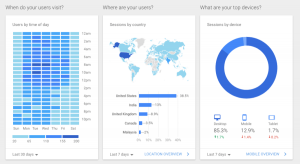Are you clinging to outdated marketing approaches and technologies? Columnist Sonjoy Ganguly says it’s time to shake things up and unlock ABM’s potential.
 “If you always do what you’ve always done, you’ll always get what you’ve always got.” This is the statement I made to my wife while we were dating, when she had concerns about my history of commitment issues. Sounds self-evident, doesn’t it? But, seven years and two kids later, it’s clear that this time, I wanted something different.
“If you always do what you’ve always done, you’ll always get what you’ve always got.” This is the statement I made to my wife while we were dating, when she had concerns about my history of commitment issues. Sounds self-evident, doesn’t it? But, seven years and two kids later, it’s clear that this time, I wanted something different.
But when it comes to the collaboration between sales and marketing — which often is effectively nonexistent — it’s amazing how many organizations persist in tired practices, tallying wins, without realizing their peril. They are running in place, at best, and they are stuck, while the world is constantly changing. This results in missed revenue opportunities.
Applying this logic to B2B marketing, it’s too easy to stay in the comfort zone and keep doing what you’ve always been doing, until you’re out of a job. Even if the team has done a great job of collectively identifying its prospect and client universe and established an ABM (account-based marketing) strategy, what most organizations are doing is not a comprehensive ABM approach.
For example, running media programs against targeted account lists, while a great place to start, is just one tactic, not a strategic initiative.
If the company is not using the most strategic approaches and technology available, to maximize the joint work between sales and marketing, well, it’s not really doing ABM to the best of its potential. After all, a single ABM tactic won’t create a magic bullet for you.
Here’s the truth: It’s time to shake it up and release the stagnation of outdated “business as usual.” It’s time to transform your business to adopt a more holistic account-based strategy. So, what’s first?
Engage your accounts
Look, making organizational changes is difficult, and the larger the organization, the more difficult it is to institute change. At the end of the day, you have revenue to generate.
You shouldn’t stop your media programs while you figure out how to change the organization. Get your account-based media programs running — FAST.
Next, update those tired KPIs
Though they may previously have been your means for measuring success, volume-based KPIs like impressions, leads, clicks or individual-based KPIs around lead conversions carry little meaning. After all, a B2B lead is not an indicator of an individual’s propensity to convert. In B2B, a lead is — at best — an indicator of a prospective account’s potential engagement.
Think about this: Your goal is not to convert an individual; your goal is to convert the entire account, which comprises multiple individuals at different places in the decision-making process. This requires a consensus sale. Therefore, get your organization away from individual KPIs and measure success with account-based metrics.
Play the long game
You don’t measure revenue at the individual level; you measure which accounts are generating the most revenue over time. Thus, your marketing KPIs should also align with your sales KPIs.
However, while revenue is the ultimate KPI, in B2B we’re generally looking at longer sales cycles. It takes time to get to revenue. Marketers need more immediate KPIs to measure their ability to reach and influence the accounts that sales wants to convert.
Audience verification is the first proof that marketing can reach and impact the accounts that sales is, or should be, prospecting. More granular data on account-level impact, such as online research activities, downloads, browsing and engagement with your site, can help you map your progress toward your ultimate objectives, then you can develop content to help you get there.
Personalize content: One size doesn’t fit all
Within the evolved symbiotic relationship between sales and marketing, you’ll need better alignment on content strategy and approach. Your content strategy will be much more effective if you can generate content that’s relevant to topics that actually interest your prospective accounts. Generating relevant content, rather than just talking about your products, will help increase trust in your brand.
Marketing and sales have to stop operating in silos. With the behavioral data described above at hand, marketing and sales should be building collaborative processes to review this data together. This way, the company will be better equipped to identify different levels of engagement and create and deliver personalized content, with insights further informing the appropriate channels and formats for delivery: video, white papers, webinars, content modules, email and so on.
Because today’s systems allow for automation here, there’s an opportunity to swiftly and efficiently optimize for ROI. A thoughtful, targeted, clearly personalized approach improves prospects’ trust, which is foundational to the eventual close.
It’s not one and done: Personalize nurturing to romance the close
One caveat on that “close.” At this point, it may go without saying that your content activation is not a one-off. But no matter how exceptional, one piece of well-targeted content does not automatically transform prospects into clients. It takes multiple touches to convert. The nurture track — your focus, sequencing, cadence and the story you’re telling with all your assets — matters.
Mastering this requires a clear view of just how decision-making has changed inside the enterprise, inside even one account. This is reflected in more complex hierarchies, more heavily loaded individual roles, or even more diffuse decision-making workflows. More thought goes into knowing, engaging and winning the decision-makers, and thus, the purchase.
Consensus selling is the new normal, as ABM engagement penetration strategy now requires consideration of size, diversity, seniority and functional area, at a higher level of detail than ever before to get from here… to there.
No single indicator from a single decision determines the close. As such, you need a multichannel marketing strategy to engage the individuals, as well as the entire account. True to its name, ABM is effectively nurturing not leads, but accounts.
Some opinions expressed in this article may be those of a guest author and not necessarily Marketing Land. Staff authors are listed here.
Marketing Land – Internet Marketing News, Strategies & Tips
(33)
Report Post









